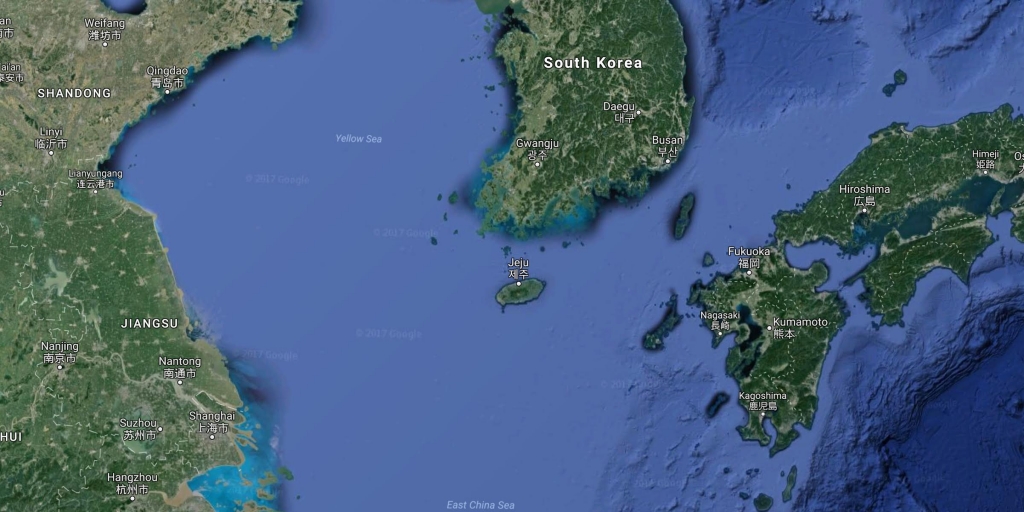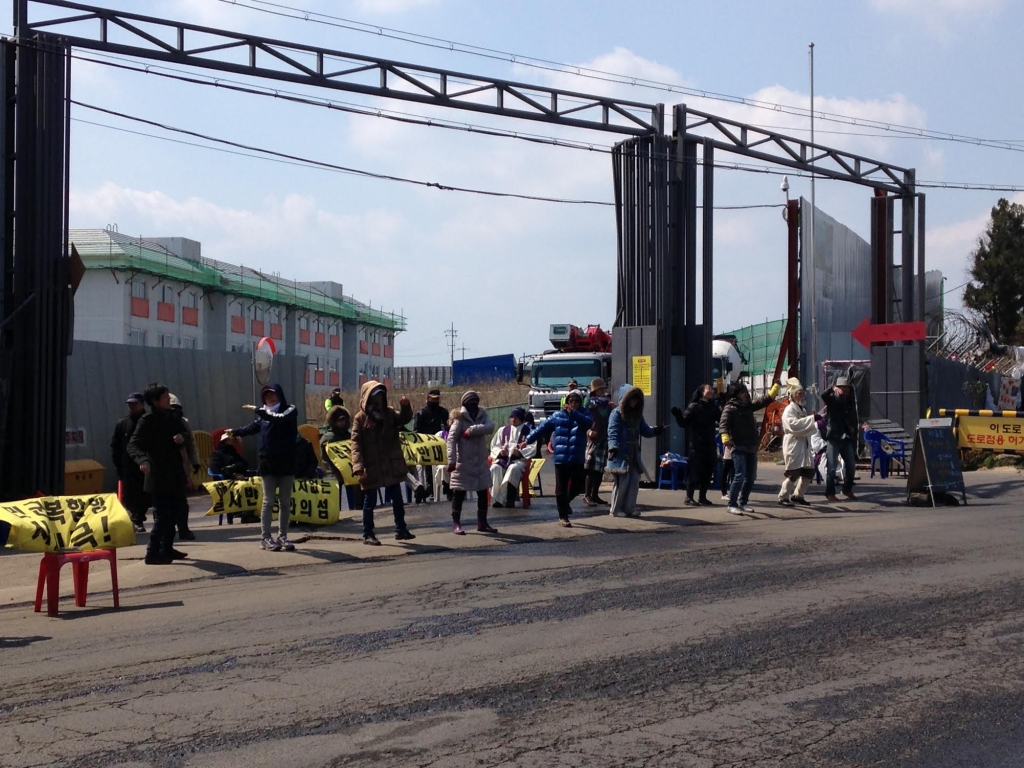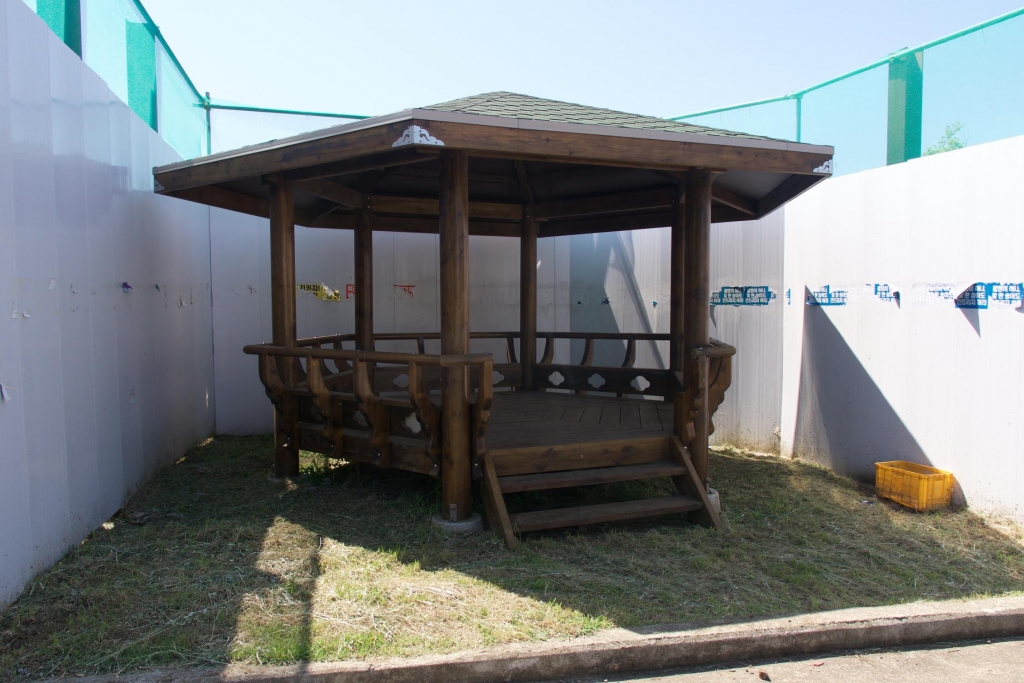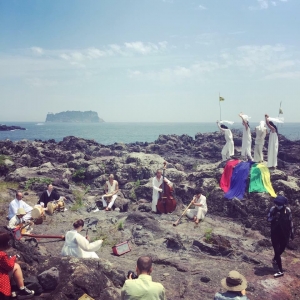By Tanner Jones

Figure 1. Silk and cloth tied onto barbed wire surrounding the construction of a naval base in Gangjeong, Jeju. Photo by author.
Jeju Island is located at the southernmost tip of South Korea, about 60 miles from the mainland coast. With a beautiful volcanic topography dominated by South Korea’s highest peak, the island was recently labeled one of the New Seven Wonders of the World and holds numerous other similar designations that attest to its natural beauty (New7Wonders, 2014).[1] Jeju is a UNESCO Natural World Heritage Site, Biosphere Reserve, and, of UNESCO’s 111 Global Geopark sites, Jeju is home to nine (Global Geo Park, 2014). In a few short decades, Jeju has undergone a rapid transformation; what was once an impoverished rural region is now one of East Asia’s most popular tourist and honeymoon destinations. While much of Jeju’s economy is driven by tourism, most of the island’s population depends on agriculture and fishing industries. Gangjeong Village, centrally located on the southern coast of Jeju, is an archetypical example of the small fishing and farming villages that dot Jeju’s coastline. In the morning, one can see haenyeo free diving into the ocean collecting various seafood. Haenyeo, or “sea women” (also known locally as chamnyeo), are arguably Jeju’s most symbolic figures of Jeju’s traditional culture and were recently inscribed as a UNESCO Cultural Heritage of Humanity (UNESCO 2016).
Despite a concerted effort by the local government to portray Jeju as an ecological marvel by touting its beautiful natural resources, there is contradictory evidence to the official rhetoric of Jeju as a natural paradise: unchecked urban expansion and rapid development, including an ecologically damaging naval base in Gangjeong Village. To give a potent example, the haenyeo used to depend on a unique 1.2 kilometer stretch of basalt rock in Gangjeong village known as Gureombi, which is known to host an array of unique sea life including red footed crab, species of soft coral, and bottlenose dolphins. The construction of the naval base, however, has irreparably damaged Gureombi. This paper explores the protest movement in Gangjeong Village that emerged in opposition to the construction of a naval base by the South Korean Defense Ministry. I focus particularly on how activists used performance informed by local shamanic practices to draw attention to sacred and culturally significant sites endangered by the construction process. Jeju shamanic practice is intrinsically musical, with sung epics and prayers and syncopated percussive accompaniment. I approach these performances through an ecomusicological framework to explore how local villagers develop relationships to these sacred sites, comparing this with how activists later draw upon those relationships in their protest performances to expand their argument to stop the naval base.
Sounding Protest
Activists have vigorously protested the naval base since the plans were brought forth in 2007, and it continues to be embroiled in controversy due to the subversive behavior the government has exhibited in order to compel their ambitions onto Gangjeong. The National Defense Ministry claims that the base is necessary to counteract any threat from North Korea. The South Korean economy is largely export driven, and the government claims that the base is necessary to protect the busy shipping lanes that traverse the Korea Straight. Also, the Defense Ministry claims that the base will be a joint military and civilian port that will allow cruise ships to dock and inject the local economy with new tourism revenue.
Local residents and activists opposing the construction of a base in Gangjeong express numerous doubts over the proposed benefits of the base. The base’s efficacy to combat an immediate threat from North Korea is questionable due its location on the southernmost tip of South Korea’s territory. (See Figure 2.) With Shanghai lying just 500 kilometers west of Jeju, residents fear that the construction of the base is more likely being urged forward by the U.S. military as a part of an effort to counteract a growing Chinese military threat. Although the South Korean government insists that no U.S. forces will occupy the base, U.S. forces assume control of all military installations in times of conflict, according to the 1953 Mutual Defense Treaty between the two governments. (Activists point out that the submarine port was built large enough to dock a Trident class submarine, the largest in the world, and only used by U.S. military forces.) Despite local opposition, the South Korean government has pushed through measures to ensure the base’s construction, albeit via underhanded methods that indicate the illegitimate nature of the project. Whereas the haenyeo were key figures in blocking measures to locate the naval base in two other villages in Jeju, authorities bribed haenyeo and other community members in Gangjeong to ensure their support (Ahn, 2011).[2] Without sufficient notice, officials held an unpublicized town hall meeting for the base’s approval during which eighty-seven of over a thousand community members, many of whom allegedly received bribes, voted in favor of the naval base construction (Chomsky-Hoey 2011).
Since 2011, activists have organized and maintained continuous protests at the naval base construction site, despite laws that have been passed that make it illegal to do so. Activists in Gangjeong have committed to maintaining a peaceful presence at the site, using nonviolent civil disobedience to hinder the construction of the base. Everyday, the Catholic Church holds mass outside the gates of the construction site in a makeshift tent covered in quilts made by participants and adorned with prayers etched in wood. After the mass, church figures and participants sing hymns and say prayers whilst sitting in the middle of the base’s main entrance point in order to stop traffic. Police repeatedly remove the obstructers from the entrance in order to allow construction vehicles to pass through. (See Figure 3.)
One of the most striking features of these protests is the overwhelming presence of music and dance. After the mass, activists boisterously direct a variety of protest songs via loudspeaker at the entrance gate, to which activists dance choreographed movements in unison, all the while blocking traffic and preventing construction crews and cement trucks from exiting and entering the construction site. Activists play diverse music as well, such as folk, trot, popular Minjung movement tunes, and rock songs all with new lyrics to voice their message of peace in Gangjeong and their defiant stance against the naval base. Throughout the demonstration police wait within the walls and allow the dancing and sit-ins to develop, and then, like clockwork, they step in after a few minutes to move those hindering traffic off to the side and let construction vehicles pass through the gates. The police then return to their place, and the protestors theirs, and the process repeats itself before the demonstrations finish. All the while buses and tourists pass by as they travel along this small seaside road adjacent to the naval base.
Activists tell me that these daily demonstrations are meant to slow down or hinder the construction of the naval base, even if it’s only for an hour. The music and sounds of these particular events serve many important purposes. Reed argues that music can act as a force that can present a crowd not as a mob but as a peaceful assembly (Reed 2005, 29). In an interview with me, one American activist visiting Gangjeong said that music and dance empowers and lifts one’s spirits. This effect is often visible on the beleaguered faces of the activists who have been fighting the base for nearly 4 years. He also believes that music and dance are by no means a one-way activity; they engage and connect those on both sides of the fence in a figurative dance they perform each day with each other, calmed or uplifted by the atmosphere promoted by the music.
In a subtle way, the music affirms the activists’ presence to outsiders and villagers alike. I recently took a walk heading away from the daily demonstration up a riverbed and through nearby farmland; there I became cognizant of how easily the rest of Jeju Island could ignore the plight of these villagers. Jeju’s central government is located two hours away in Jeju City, which lies over Halla Mountain; Gangjeong village is situated some distance removed from a main highway that connects the popular Jungmun tourist resort area to nearby Seogwipo City. Most travelers pass by this farming village with little awareness. One local informed me that the villagers have no strength left to keep fighting, nor can they afford to. Local villagers have resigned to return to their farms and businesses and do not regularly participate with the protests. As I stood amongst the farms and listened to the amplified protest songs in the distance, I realized that this music was an equally important reminder to those villagers that some are still committed to fighting the base’s construction.
Ritual and Protest
In The Art of Protest, Reed argues that one of the key functions of culture in movements is its ability to link movements with “traditional” genres and create a feeling of continuity over a long span of time. Both Reed and Turino note the use of “traditional” gospel songs in the American civil rights movement, arguing that they gave a gentle reminder of the struggles of their ancestors (Reed 2005, 15; Turino 2008, 215). Similarly, Katherine Lee has shown how traditional Korean percussion was politicized in South Korea’s minjung democracy movement in the 1980s and represented the music of the common people (Lee 2012, 179-205). There is a sense that many people throughout the island consider the naval base only in terms of its political and economic advantages or disadvantages. I have rarely heard opinions that consider the consequences of the base in terms of how it may affect the local environment, people, their way of life, and their cultural values.
In Gangjeong, protesters have highlighted ecological damage done to the area caused by construction by connecting with and highlighting the traditional shamanic beliefs and practices of the area. Haenyeo and villagers have relied on their connection to the spirits of the surrounding waters and land to help navigate their dangerous profession. The village’s haenyeo association annually sponsors a large shamanic ritual called the Jamsu-Kut or Yeongdeung-Kut, in which the women pray for their fortune and safety and shamans propitiate the spirits and divine where and when to fish, what to seek, and what to avoid (perhaps aiding in their environmentally responsible fishing practices) (Reckinger 2014, 83). Villagers also frequent their local shindang (spirit shrines) and haeshindang (seaside shrines used by fishermen and haenyeo) to make personal offerings and prayers to the local deities.
The performance of shamanic rituals and artistic performances inspired by local shamanic practices in Gangjeong throughout this movement can be seen as a dynamic display of the village’s spiritual and physical connection to this area. The village’s economic dependence on the coast through fishing and diving is immediately discernible and is a recognized concern by outsiders. However, this economic acknowledgement seems to neglect the complex spiritual relationship the local people have with this area, including the multiple natural sites associated with local mythology and traditional religious practices. These natural holy sites (shindang) hold significant historical, cultural, and political value. Two places in particular, a seaside shrine (haeshindang) and a natural spring that once emanated from Gureombi Rock, have been directly affected by the construction of the naval base. As a result, they have since become symbols of the naval base’s destructive impact on local cultural and religious practices.
Jeju’s shamans are custodians of their area’s shrines and deities, of which Gangjeong is home to a quite a few. The local shaman (shimbang), Jeong Gong-Jeol, was well known throughout the island for his prowess in rituals, as well as his activism against the base. The earliest evidence I have found of shamanic ritual employed in conjunction with the protests was a particular rite called Sallim Kut in 2011. Reportedly, it had been many years since this rite was performed. One observer, Mr. Han, noted that the main purpose of this ritual was to pray to the sea gods for help in the struggle against the naval base and to pray for peace. Unfortunately, this shaman passed away last year, and I was unable to find the exact content of this particular ritual.
Those who attended the ritual were mostly activists who actively voiced disapproval of the naval base, including the mayor of Gangjeong village (Sallim Kut, 2011). It is important to note that, historically, the practice and adherence to shamanic belief in Korea has often been stigmatized. Shamanism was seen as a charlatan practice by the ruling Confucian aristocracy throughout the Joseon period, and was forbidden under the rule of the Japanese colonial powers and subsequent South Korean dictators. Even currently, shamanism is not listed as a religion on the national census. However, this ritual was performed directly beside the walls of the naval base in a public space at the village’s ancestral shrine, attended by significant figures of the movement and community. Many of Jeju’s shamanic rituals are public events that are generally attended by women who pray for their family, farm, and business. Nonetheless, whatever the beliefs of the mayor and those in attendance may have been, I argue that the ritual participation of the activists was significant beyond a spiritual plea. The ritual expressed the acknowledgement of this area’s deeper cultural value, linking it to spiritual practices of the local people that have continued to be ignored by external forces. Shamanic rituals in Jeju use a small hourglass drum (janggwi), large barrel drums (ulbuk), large gongs (taeyang), and a piercingly loud suspended bell (seolssoe). This shrine is located just meters beyond the rocky coastline, next to a river that pours into the ocean towards the nearby Tiger Island (Beom seom). The highly percussive and syncopated ritual music resonated throughout the space, extending to the naval base area to send a powerful message to those involved in its construction, as well as to foreign tourists residing in nearby hotels.
According to Byerly, successful protest movements need to strive for an “expanding spectrum of players drawn into the movement,” which include a wide array of musical genres to draw in activists (Byerly 2013, 240). The Save Jeju Movement has done this remarkably well both locally and internationally. Catholic and protestant protestors are one of the most dominant forces in the movement. The Catholic Church officially supports peace activism, thus making Catholics the most organized entity (Pae 2014, 61). The presence of the Sallim Kut shamanic ritual is a good example of the acceptance of various actors into the larger protest movement in Gangjeong.
Another area of contention is a nearby seaside shrine that is under threat of being destroyed by the naval base’s ever expanding boundary. I was recently given a tour of Gangjeong’s many shamanic spirit shines (shindang), and this shrine in particular struck me as indicative of the village’s current situation. Called “Saebyeol GoJi Dang,” this shrine is located just above the sea and hosts the sea gods. Typically, fishermen and diving women (haenyeo) use this shrine to pray for a bountiful catch, as well as for fertility or for healing illnesses afflicting children. The physical and natural attributes of this shrine are important to the local people. Mr. Han explained to me that this shrine stands on a piece of rock that extended into the sea floor, acting as a connection between earth and sea, where the Yowang dragon deity resides. He pointed out that some newly erected 20-foot tall fence posts extending from either side of the shrine’s entrance threaten to enclose it. As he posited to me in a 2014 interview, “This area is facing a crisis of disappearing. If this shrine disappears, then it is representative of the sea disappearing from Gangjeong.” (See Figure 4.)
He went on to explain that the navy offered to put the fence around the shrine, leaving it untouched. However, the villagers argued that this would disrupt the unique physical and spiritual connection between the land and the sea, and the energy (ki) would be destroyed. Villagers that have used this shrine to pray for family, fortune, and health, would be prevented from practicing rituals because of the physical barrier. Thus, traditional practices would be forcibly discontinued, and a prominent part of this area’s traditional culture would be further suppressed. Unfortunately, the shrine was partially damaged when the construction company drove a crane into it in order to remove palm trees that they wished to sell. This caused an uproar in the community, and was further evidence of the perceived lack of care or consideration for the local people, as outsiders took no notice of this significant landmark as they worked to their own capital gain. Activists in Gangjeong initially cited economic and environmental concerns as their main argument to disrupt the construction of the naval base, and their pivot to elucidate the spiritual and cultural value of the land was perhaps too late to stop further destruction of the area. Authorities imposing the base upon Gangjeong have downplayed the area’s cultural significance, systematically removing evidence of any cultural relationships with these spiritual sites.
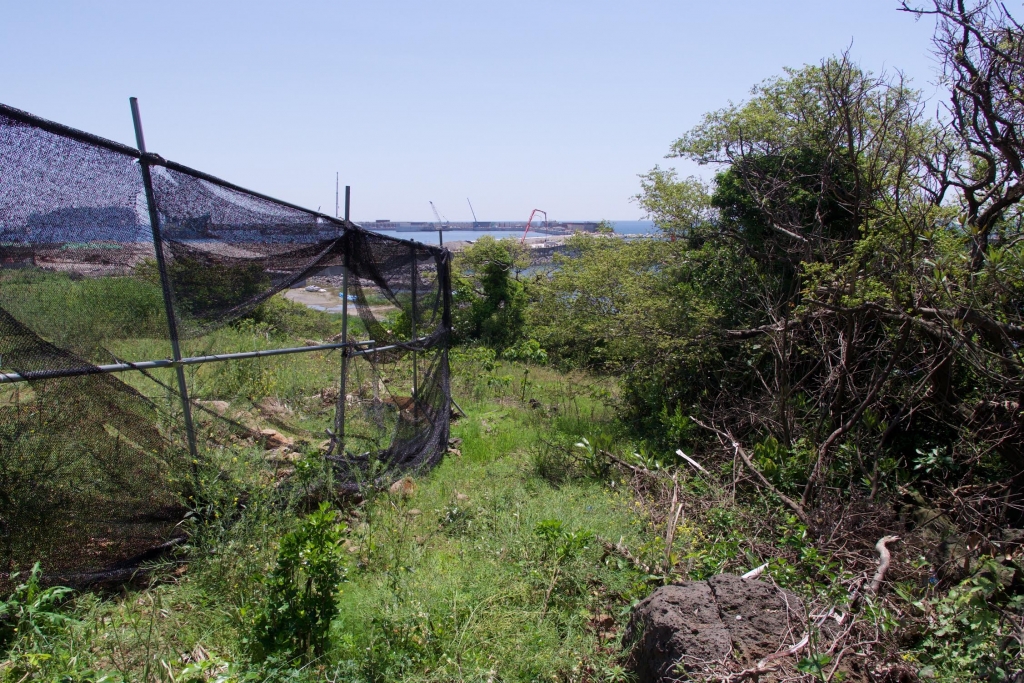
Figure 4. A gazebo (above) that once overlooked Gangjeong’s unique coastal area, now enveloped by a fence surrounding the naval base construction site. A few meters down the road, the seaside shrine (below) that was almost destroyed by construction crews, and later almost fenced in like the gazebo. Photos by author.
On March 7, 2015, roughly around the third anniversary of the destruction of Gureombi rock, Tera, a local artist and dancer created a performance called “Let’s Go Meet Halmang Mul” (Grandmother’s Spring).[3] Located on the currently destroyed Gureombi rock, “Grandmother’s Spring” was performed at a particularly spiritual site for the local people. Any time one went to a ritual, they would need to bring water from Halmang Mul; if someone had a baby or was pregnant, they would travel to Halmang Mul to pray and drink the spring water. In a performance that paraded throughout Gangjeong village, Tera played the role of the Grandmother (halmang), followed by other performers and activists that held on to a long silk string (used as an offering to pray for longevity), upon which paper money for the spirits were attached. (See Figures 1 and 5.) For the performance, Tera took a jar of water from Netgiriso (a lake that supplies Halmang Mul) and went to the seaside to bury it beside the walls of the naval base. Much to the performer’s surprise, older village women came outside and placed money on the strings, clasped their hands and bowed, just as one would at a ritual. One activist explained to me this was somewhat unexpected, as last year during a parade for the same anniversary, the older village people would have no part of it. The performance ended with participants and observers placing paper money on the barbed wire fence surrounding the naval base to pray for peace, and the grandmother disappearing into the distance.
Tera has been a resident of Gangjeong since the early stages of the movement. An artist, dancer, farmer, and peace activist, she has become an active figure in the protests, particularly in creating performances that aim to reinvigorate interest in Gangjeong’s endangered sacred sites and their mythology. As she explained to me in a 2015 interview, “I am fighting through creating my dance, and making [other] people dance… My dream is creating and performing real Gangjeong stories, and traditional story art in Gangjeong’s nature.” These performances are meant to not only emphasize the importance of these revered natural sites, but also highlight the local people’s spiritual connection to them. The fact that this performance stirred an emotional or spiritual connection with the local residents is further evidence of the spiritual significance of these sites afforded by the local people.
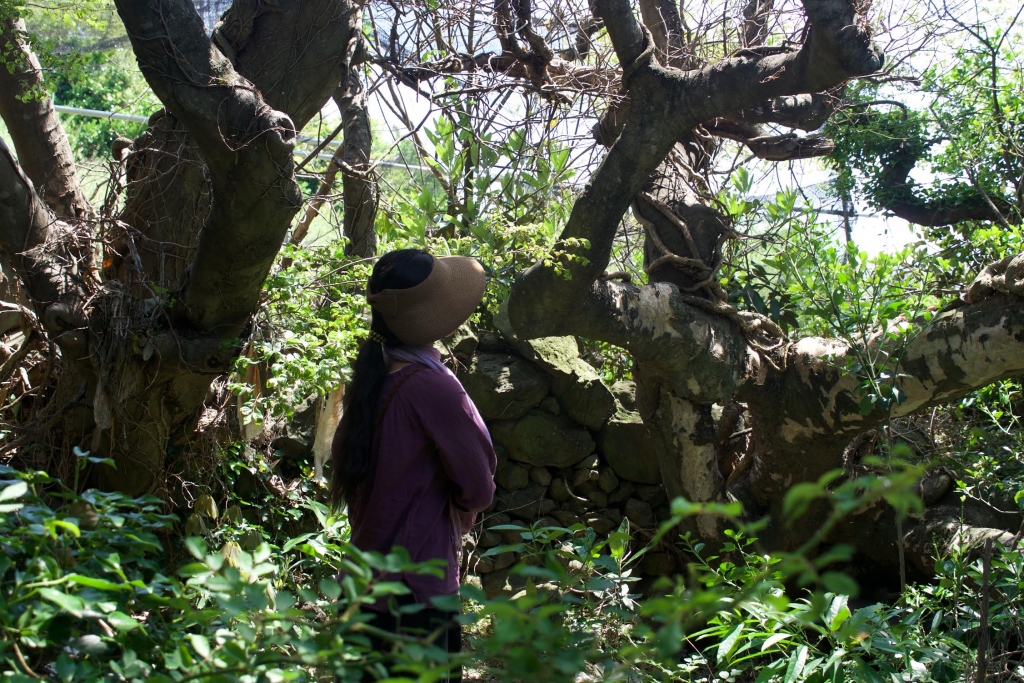
Figure 5. Tera, an activist, performance artist, and Gangjeong resident, pays her respects to the Saebyeolgoji Dang, a seaside shrine next to the naval base construction. Photo by author.
On the rocks of Metburi, located by the sea just beyond the base construction, another performance was held on May 24, 2015, that combined local shamanic mythology, ritual music, dance, and protest. (See Figure 6.) In this performance, local scholar, writer, and musician Mr. Han wrote and sang Gureombi Halmang Prayer in the style of Jeju’s shamanic epic songs. After this prayer, a drummer played a slow rhythm unique to Jeju shamanism, which typically accompanies the shaman bowing to and greeting the spirits. Multiple dancers appeared, who represented spirits of the Gangjeong and the Gureombi Halmang, who began the performance by attempting to go to her seat at Halmang Mul, only to be stopped by the 20-foot tall fence. In addition to the local protesters, this performance was primarily attended by non-local residents who had come for a market place event to highlight the area’s agriculture.
Allan Moore observes that music can alienate and inhibit chance for dialogue, and this is substantiated by Samson’s case study of Tiananmen Square, where music defined insiders and outsiders (Samson 2012, 518). Before I began my fieldwork, I had believed that performances related to shamanism, which has long carried a negative stigma, might potentially create friction between different factions of the movement. Contrary to my earlier presumptions, I have witnessed a positive response from observers, who appreciated the performance’s ability to educate outsiders on the history, cosmology, and mythology of the area. Movements that are able to adapt to existing cultural structures can more effectively use those structures to support new goals, ideas, and strategies (Reed 2005, 300). Various actors within the “Save Jeju” movement have been able to imbue local cultural identity into their struggle and provide a human face that is integrally bound to this environment. Tilly argues that this creates a historically and culturally engrained identity that is necessary for coherence (Tilly 2008, 14-17).
Based on the evidence of officials bribing the haenyeo, one might argue that the navy sought to undercut resistance by silencing or destroying the area’s cultural symbols or figures before beginning the project. One activist suggested to me that he believes the destruction of Gureombi rock was seen as a symbolic act by the navy, meant to dishearten the opposition and an attempt to remove any cultural significance associated with the local environment. While the Korean government has ignored economic and environmental damage to this area, these performances by activists can be seen as an attempt to illuminate the cultural loss being wrought by the destruction of these natural worship sites. Despite the stigmatization of shamanism in Korea, the Halmang Mul performance was successful in igniting community solidarity in protesting the damage to the seaside shrine. In doing so, it relied on a traditional shamanic narrative to do the cultural work of restoring value to that area. Such an approach is not unique; for example, native Hawaiians fought to regain control over Kaho’olawe Island by asserting the island’s cultural and historical importance as a sacred site after decades of use by U.S. military forces as a site for target practice (Blackford 2004, 571). Similarly, activists in Gangjeong have sought to appeal to native cultural values and religious practices to broaden their protest narrative beyond the exclusively environmental. Considering the ecologically complex whole involving cultural identity, place, and politics, I argue that these performances illuminated deeper relationships between the people and this locale to the opposition, thereby demonstrating the far-reaching consequences of this construction project.
Papers from this panel:
2. Tanner Jones, “Military Expansion on the ‘Island of Peace’: Protest Through Ritual”
3. Megan Murph, “Max Neuhas’s Sound Works and the Politics of Noise”
4. Ben Norton, “Thin Green Line: Environmental Politics and Punk Music”
References
Ahn, Christine. 2011. “Naval Base Tears Apart Korean Village.” Foreign Policy in Focus. August 19. Accessed September 14, 2014. http://fpif.org/naval_base_tears_apart_korean_village/
Blackford, Mansel G. 2004. “Environmental Justice, Native Rights, Tourism, and Opposition to Military Control: The Case of Kaho’olawe.” The Journal of American History 91(2): 544-571.
Byerly, Ingrid Bianca. 2013. “What Every Revolutionary Should Know: A Musical Model of Global Protest.” In Routledge History of Social Protest in Popular Music, edited by Jonathan C. Friedman, 229-247. New York: Routledge.
Choe, Sang Hun. 2011. “Island’s Naval Base Stirs Opposition in Korea.” New York Times, August 18.
Chomsky, Noam and Matthew Hoey. 2011. “Preserving the Island of World Peace.” Hankyoreh, September 30. Accessed October 15, 2014.
Global Geo Park. 2014. “Distribution of GGN Members.” Accessed September 30, 2014. http://www.globalgeopark.org/homepageaux/tupai/6513.htm
Hollings, Fritz. 2011. “Wasting Lives and Money.” Huffington Post, June 15. Accessed January 2, 2017. http://www.huffingtonpost.com/sen-ernest-frederick-hollings/wasting-lives-and-money_b_877380.html
Huh, Ho-joon. 2012. “Supreme Court Overturns Ruling on Jeju Naval Base.” Hankyoreh, July 7. Accessed September 30, 2017. http://english.hani.co.kr/arti/english_edition/e_national/541468.html
Interview, October 21, 2014. Full identity withheld.
Jeju Island Geopark. 2014. “Jeju Island Geopark.” Accessed September 30, 2014. http://geopark.jeju.go.kr/english/?sso=ok
Kim, Jeanne. 2014. “The Chinese Are Buying up South Korea’s Jeju Island, and the Islanders are Not Too Pleased.” Quartz Media. Last modified September 11, 2014. Accessed June 1, 2017. http://qz.com/259419/the-chinese-are-buying-out-south-koreas-jeju-island-
Kim Tae Jong. 2011. “Police Disperse Protestors At Gangjeong.” Korea Times, September 2. Accessed June 5, 2017. http://www.koreatimes.co.kr/www/news/art/2011/09/117_94092.html
Lee, Katherine In-Young. 2012. “The Drumming of Dissent during South Korea’s Democratization Movement.” Ethnomusicology 56(2): 179-205.
New7Wonders. 2014. “Jeju Island: South Korea.” Accessed September 14, 2014. http://world.new7wonders.com/the-new7wonders-of-nature/jeju-island-korea-south/
Pae, Keun-Joo Christine. 2014. “Feminist Activism as Interfaith Dialogue: A Lesson from Gangjeong Village of Jeju Island, Korea.” Journal of Korean Religions 5(1): 55-69.
Peddie, Ian, ed. 2006. Resisting Muse: Popular Music and Social Protest. Ashgate Publishing, Ltd..
Personal conversation, October 22, 2014, Identity withheld.
Reed, Thomas Vernon. 2005. The Art of Protest: Culture and Activism from the Civil Rights Movement To The Streets Of Seattle. Ann Arbor: University of Michigan Press.
Sacred Natural Sites. 2014. “Gureombi coastal sacred site and Gangjeon village, Jeju Island, South Korea.” Accessed October 1, 2014. http://sacrednaturalsites.org/items/gureombi-coastal-sacred-site-and-gangjeon-village-jeju-island-south-korea/
Samson, Valerie. 2012. “Music as Protest Strategy: The Example of Tiananmen Square, 1989.” In Music and Protest, edited by Ian Peddie, 518-527. Ashgate: New York.
Save Jeju Now. 2014. “Endangered Species.” Accessed September 14, 2014. http://savejejunow.org/portfolio/endangered-species/
Save Jeju Now. 2015. “Police Crackdown on Sit-in Tents, Part 1.” Accessed August 18, 2015. http://savejejunow.org/portfolio/police-crackdown-on-sit-in-tents-part-1/
Steinem, Gloria. 2011. “The Arms Race Intrudes on Paradise.” New York Times, August 6.
Tilly, Charles. 2008. Contentious Performances. Cambridge: Cambridge University Press.
Titon, Jeff Todd. 2013. “The Nature of Ecomusicology.” In Música e Cultura: revista da ABET 8(1): 8-18.
Turino, Thomas. 2008. Music as Social Life: The Politics of Participation. Chicago and London: University of Chicago Press.
UNESCO. 2007. “UNESCO Confirms That It Is Not Involved in the ‘New 7 Wonders of the World’ Campaign.” Last modified July 9. http://whc.unesco.org/en/news/352.
UNESCO. 2016. “Culture of Jeju Haenyeo (Women Divers).” Accessed January 10, 2017. http://www.unesco.org/culture/ich/en/RL/culture-of-jeju-haenyeo-women-divers-01068.
Yamamoto, Eric K., Sara Lee, and Yae Jin Lee. 2012. “The United States’ Role in the Korea Jeju April 3rd Tragedy and its Responsibility for ‘Social Healing Through Justice.’” World Environment and Island Studies 1: 49-57.
Yonhap. 2016. “No. of Visitors Tops 5 Mln.” Last modified May 5. http://english.yonhapnews.co.kr/news/2016/05/09/0200000000AEN20160509006800315.html
Endnotes
[1] Admittedly, being recognized as one of the “New Seven Wonders of the World” may be a rather dubious distinction. It was earned through a popular vote, and rumors abound that local government employees were required to make hundreds of votes a day to secure Jeju’s selection. UNESCO also publicly announced their disassociation with the initiative (UNESCO, 2007).
[2] Jeju’s haenyeo are typically joined in associations (Haenyeo Chon) that manage that village’s fiercely guarded fishing territory. Thus, the haenyeo are respected authority figures in their area.
[3] Halmang means grandmother in the Jeju language, however, it is also a ubiquitous term for a female spirit. Often villagers will not know the name of the spirit, but will just refer to the deity as “Grandmother.”
Tanner Jones is a Ph.D. Candidate in Ethnomusicology at the University of Kentucky. Tanner has recently returned from a year in Jeju-do, South Korea, where he completed his field research funded by a Fulbright IIE research grant. He is currently writing his dissertation, entitled Performing Agency and Change Through Jeju Shaman Ritual, funded by the Fellowship for Graduate Studies from the Korea Foundation.
